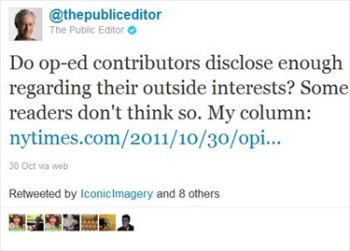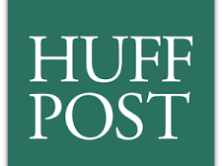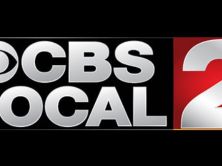
The NYT public editor Arthur Brisbane addressed transparency in his latest column. (credit: Twitter)
New York Times public editor Arthur Brisbane weighed in on criticism of the Times’ op-ed writers. Mirroring former Washington Post public editor Andrew Alexander’s December 2010 comments on readers’ desire for transparency, Brisbane noted that readers question guest op-ed writers and any possible conflicts of interest or “hidden interests and agendas.”
Brisbane also addressed True Ties’ October petition calling for transparency from the Times, which iMediaEthics has written about. The petition to the Times asks the newspaper to offer more information about its op-ed writers’ potential conflicts of interest and has been signed by numerous journalists.
Brisbane defended guest op-ed writer Robert Bryce, whose “The Gas is Greener” piece was singled out by True Ties because of Bryce’s work as a senior fellow at the Manhattan Institute. As Brisbane explained, the institute “got financial support from the fossil fuel industry,” an area which Bryce wrote about. However, Brisbane defended Bryce, noting that the institute only gets “slight” funding from the industry and he is an authority on the subject.
Brisbane added that op-ed contributors to the Times must “sign an agreement that states, ‘You agree to disclose to The Times any financial interest you may have in the subject matter of the article.'” Further, editors question writers about potential conflicts as well.
Brisbane noted that readers also question the brevity of author biographies at the end of the article. ” Some readers want to see a more exhaustive bio, not merely what’s in the author line,” which is problematic because some writers have many affiliations that can’t possibly be included.
“While I recognize that The Times has limited space in print to provide more disclosure, I believe it should do more to help readers learn about outside Op-Ed contributors,” Brisbane wrote. He also recommended that print op-eds include any “current paid role” writers serve. Online, Brisbane suggested adding links to any affiliations writers have, and publishing an online list of “all current paid positions.”
However, in closing, Brisbane noted that “even if“ the Times included all this information, “some reader will ask for more.” This StinkyJournalism questions this logic. Would the Times simply not disclose the information because of fears about what “some reader” would say? iMediaEthics doesn’t see how including links and providing more information about non-NY Times writers and their backgrounds could hurt.
Read Brisbane’s full column here.






